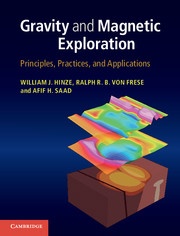Book contents
- Frontmatter
- Dedication
- Contents
- Preface
- Acknowledgements
- 1 Introduction
- Part I Gravity exploration
- Part II Magnetic exploration
- 8 The magnetic method
- 9 Magnetic potential theory
- 10 Magnetization of Earth materials
- 11 Magnetic data acquisition
- 12 Magnetic data processing
- 13 Magnetic anomaly interpretation
- Part III Applications
- Appendix A Data systems processing
- References
- Index
8 - The magnetic method
from Part II - Magnetic exploration
Published online by Cambridge University Press: 05 May 2013
- Frontmatter
- Dedication
- Contents
- Preface
- Acknowledgements
- 1 Introduction
- Part I Gravity exploration
- Part II Magnetic exploration
- 8 The magnetic method
- 9 Magnetic potential theory
- 10 Magnetization of Earth materials
- 11 Magnetic data acquisition
- 12 Magnetic data processing
- 13 Magnetic anomaly interpretation
- Part III Applications
- Appendix A Data systems processing
- References
- Index
Summary
Overview
The magnetic method is the oldest and one of the most widely used geophysical techniques for exploring the Earth's subsurface. It is a relatively easy and inexpensive tool to apply to a wide variety of subsurface exploration problems involving horizontal magnetic property variations from near the base of the Earth's crust to within the uppermost meter of soil. These variations cause anomalies in the Earth's normal magnetic field that are mapped by the magnetic method.
The geomagnetic field is caused by electrical currents associated with convective movements in the electrically conducting outer core of the Earth. Additional significant components of the field are derived from variations in the magnetic properties of the lithosphere and electrical currents in the ionosphere as well as in the Earth. The main field roughly coincides with the Earth's axis of rotation and is dipolar in nature. The force of attraction between opposite magnetic poles, or repulsion between like poles, is proportional to the product of the strength of the poles and inversely proportional to the square of the distance between the poles in a manner analogous to the gravitational attraction between masses. For most exploration purposes the magnetic force per unit pole, or magnetic field strength, is measured either in a directional mode where the sensor is spatially oriented or in a non-directional mode where the sensor obtains total field measurements that are presumed to be collinear with the Earth's magnetic field. Modern magnetic measurements are obtained electronically by measuring the precession of atomic particles which is proportional to the ambient magnetic field.
- Type
- Chapter
- Information
- Gravity and Magnetic ExplorationPrinciples, Practices, and Applications, pp. 215 - 234Publisher: Cambridge University PressPrint publication year: 2013
- 1
- Cited by



